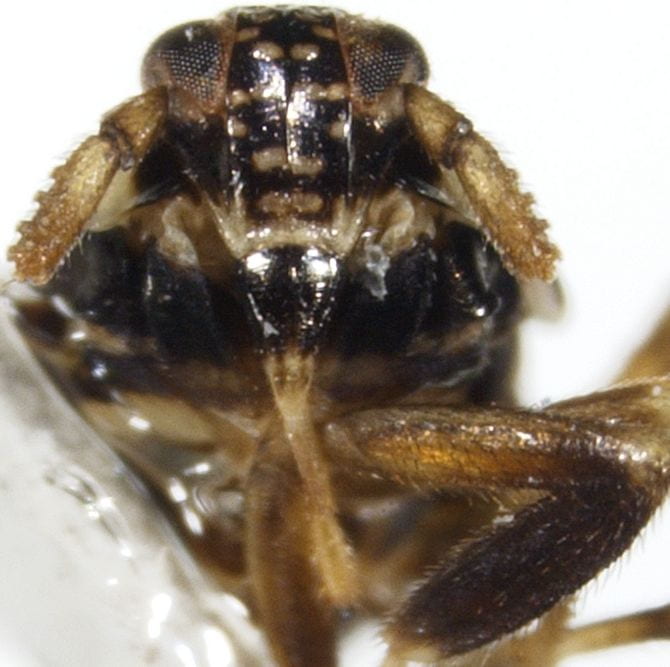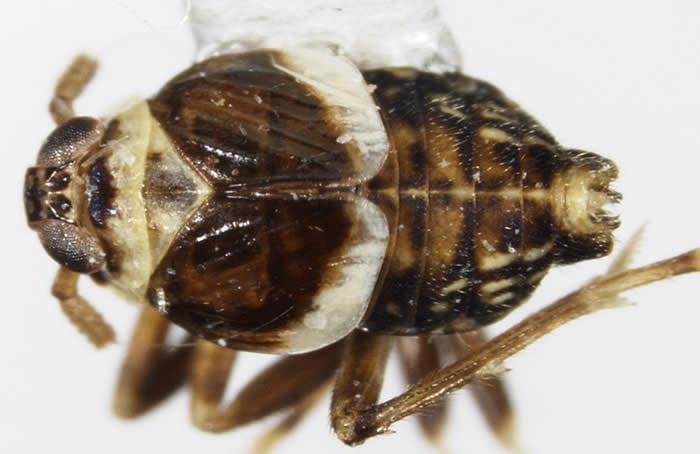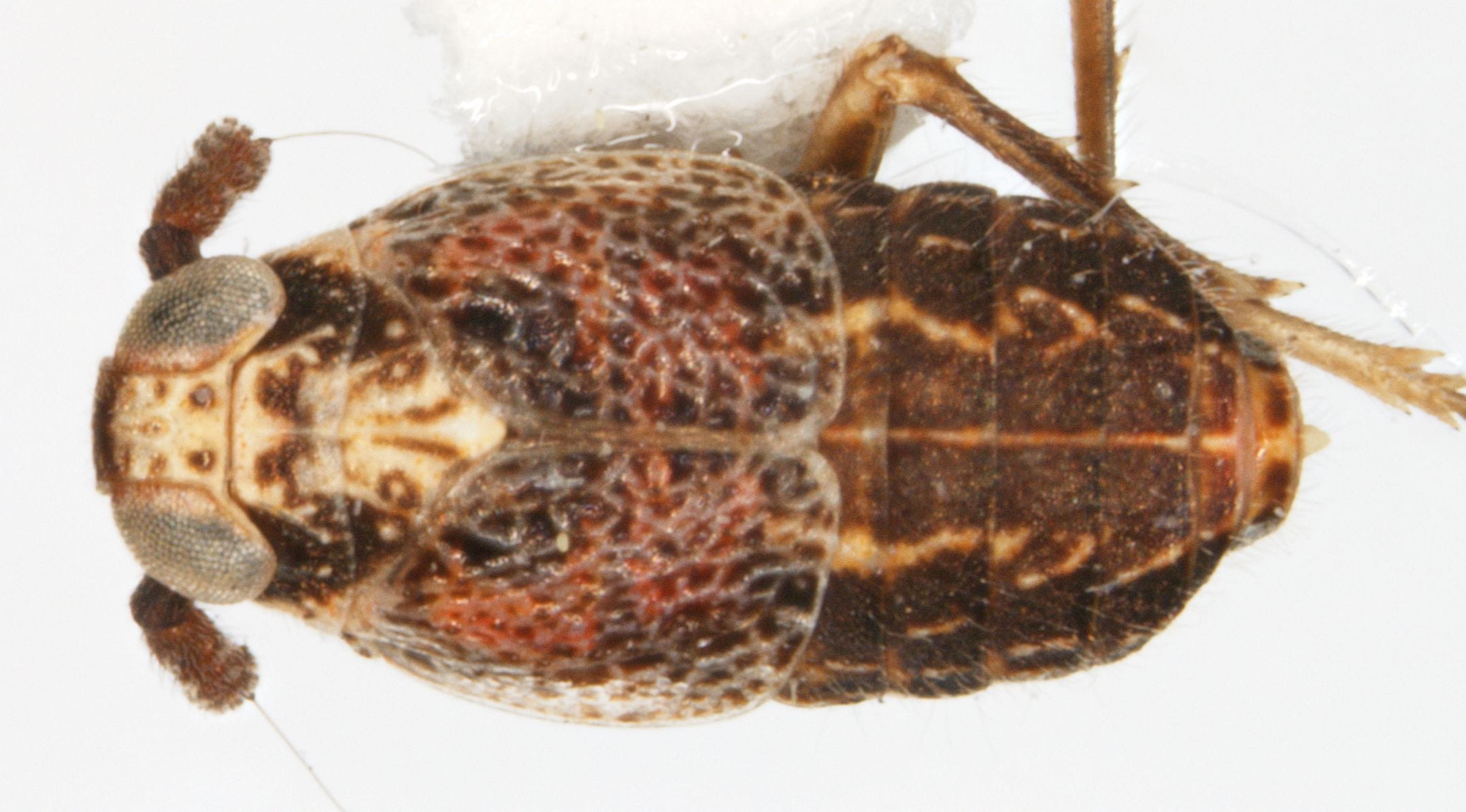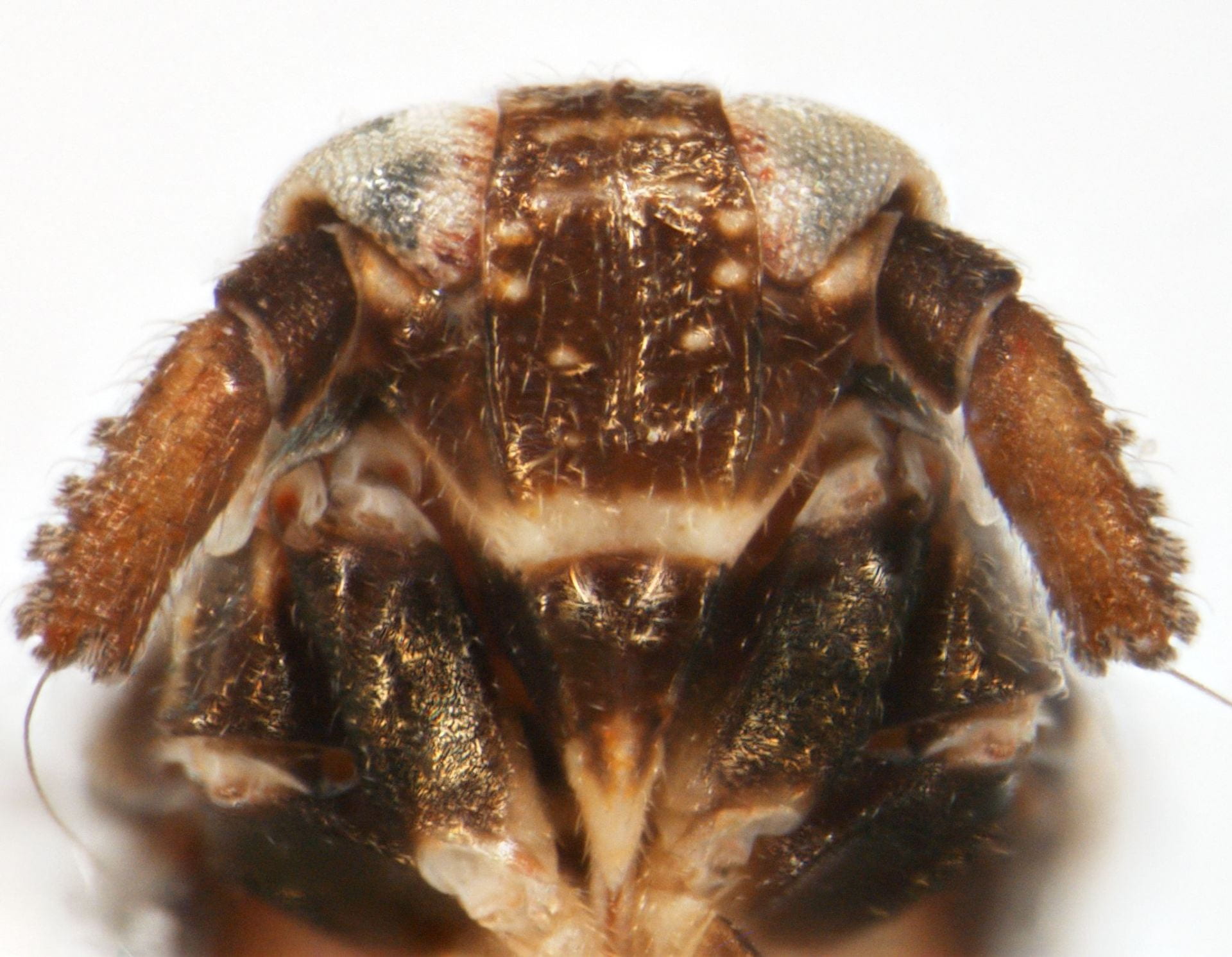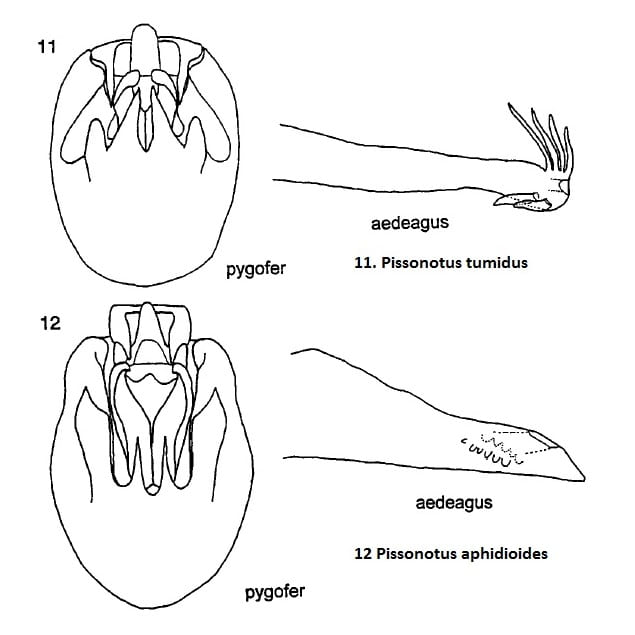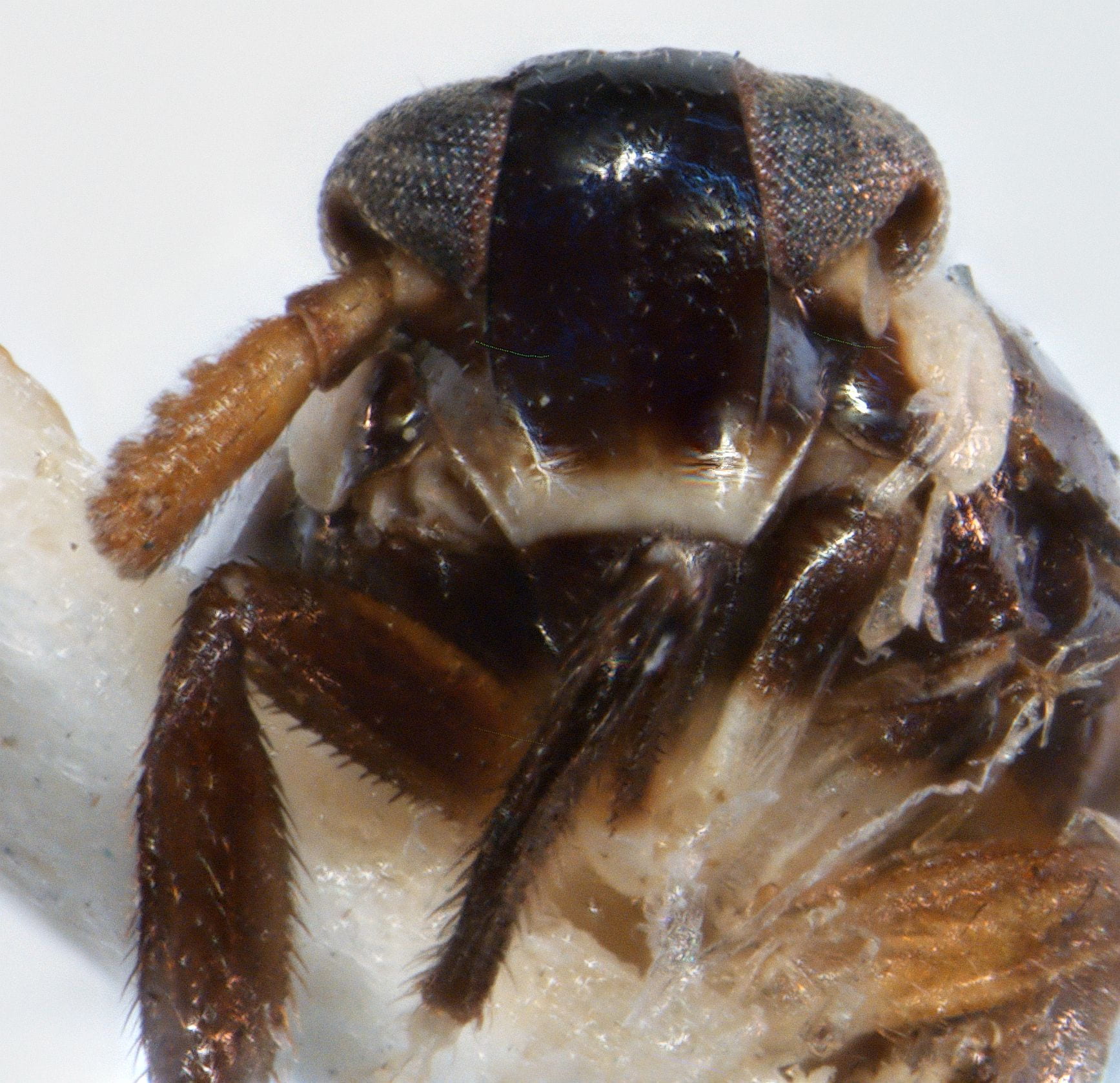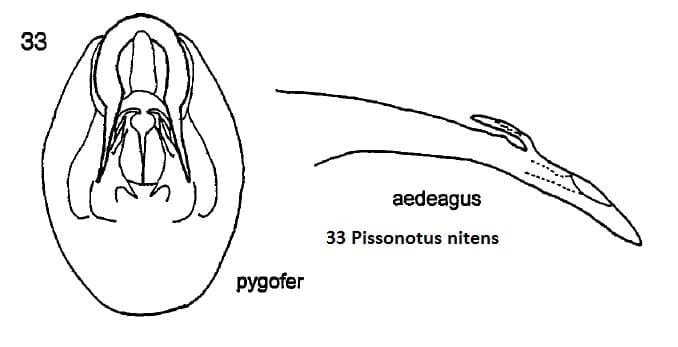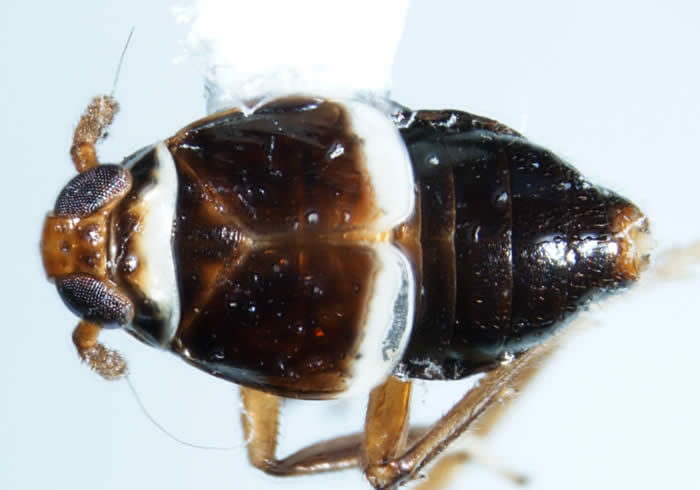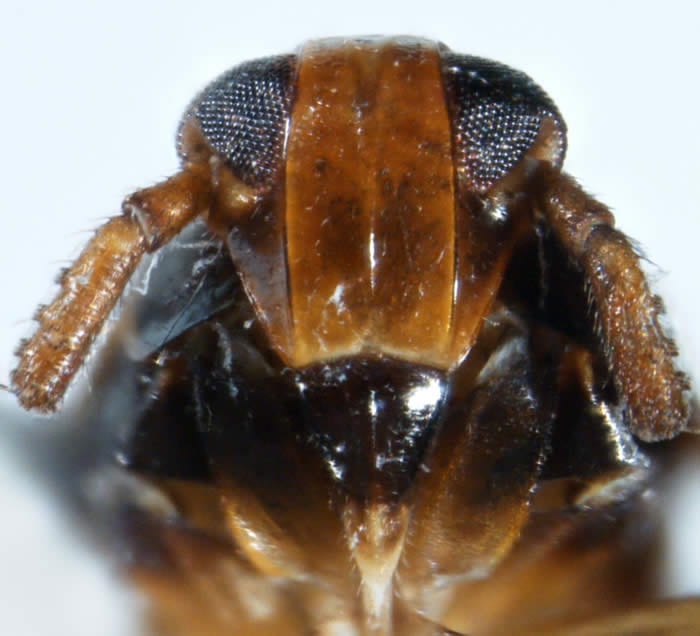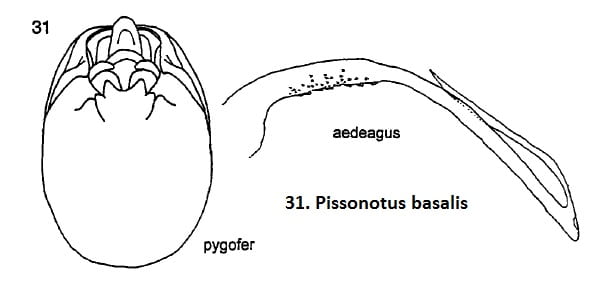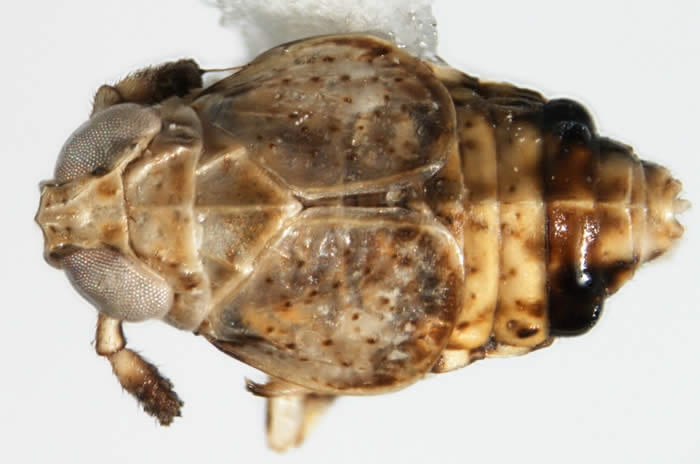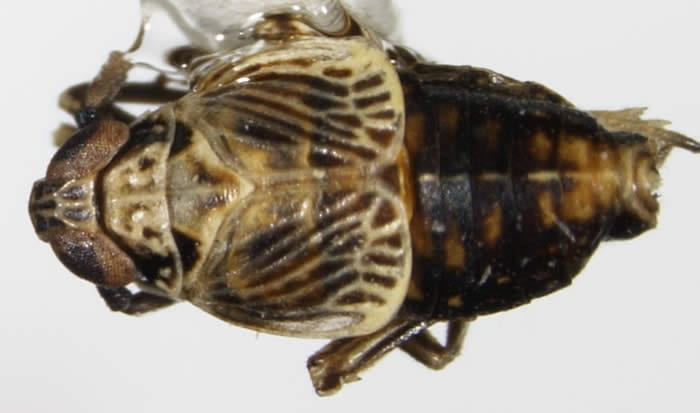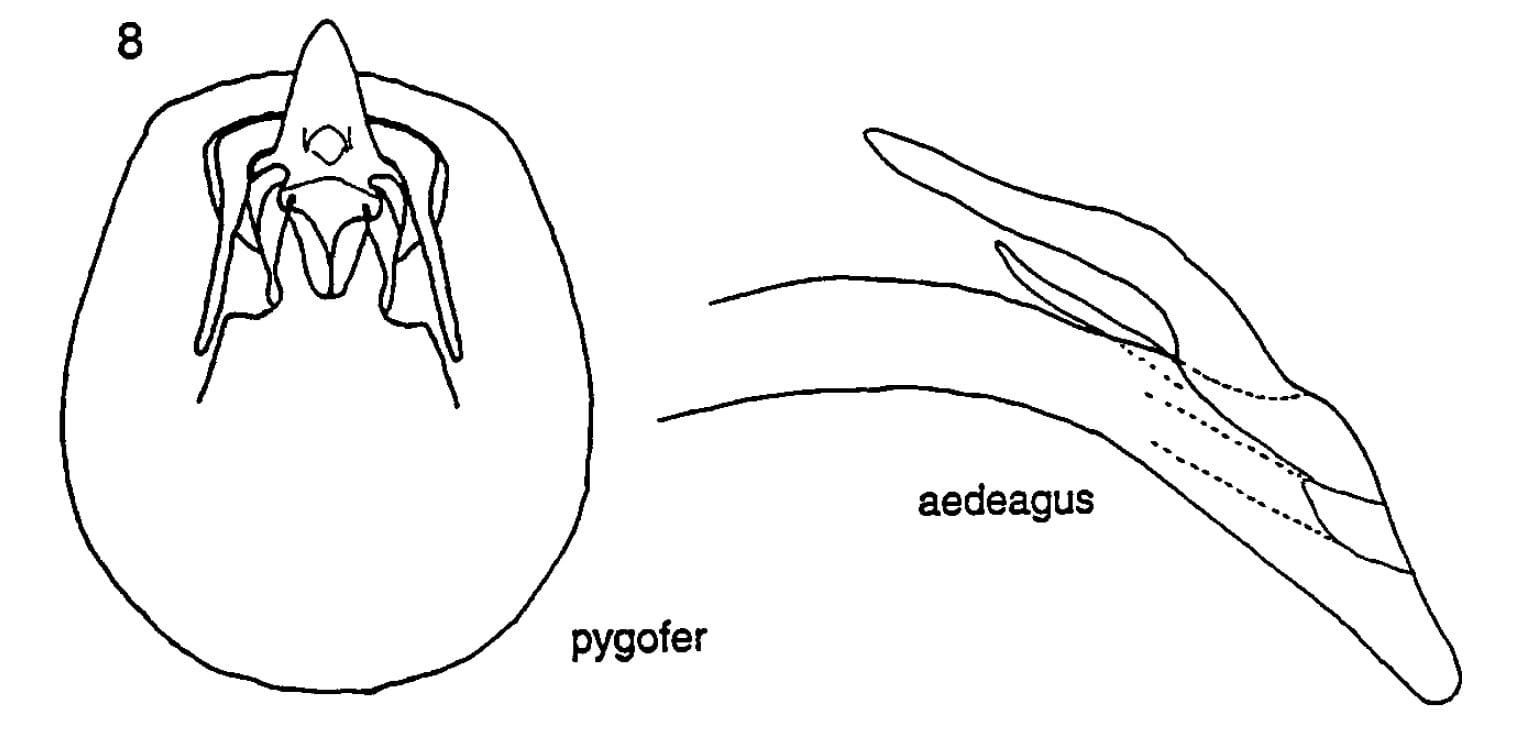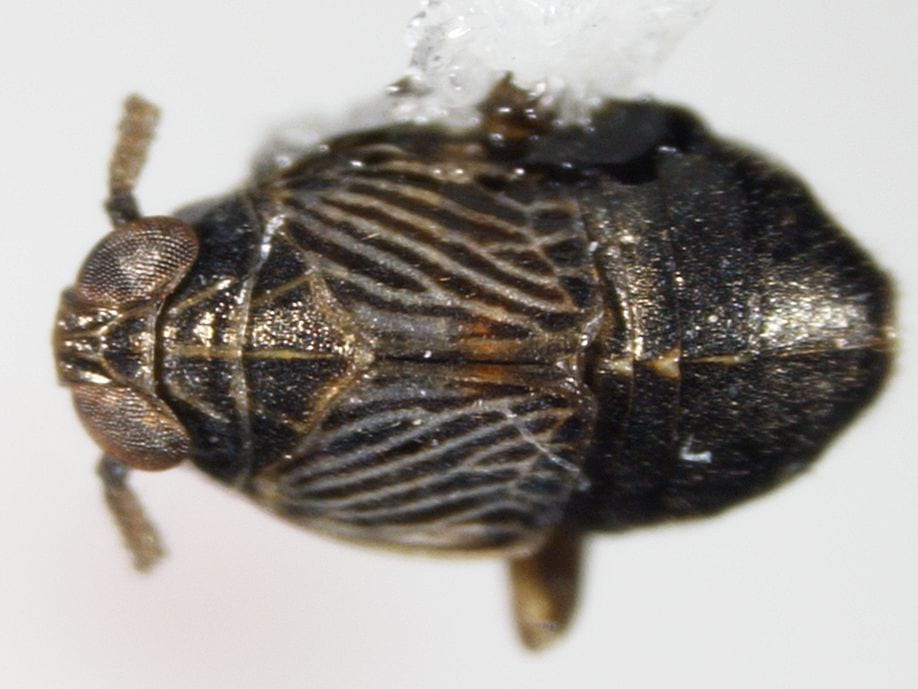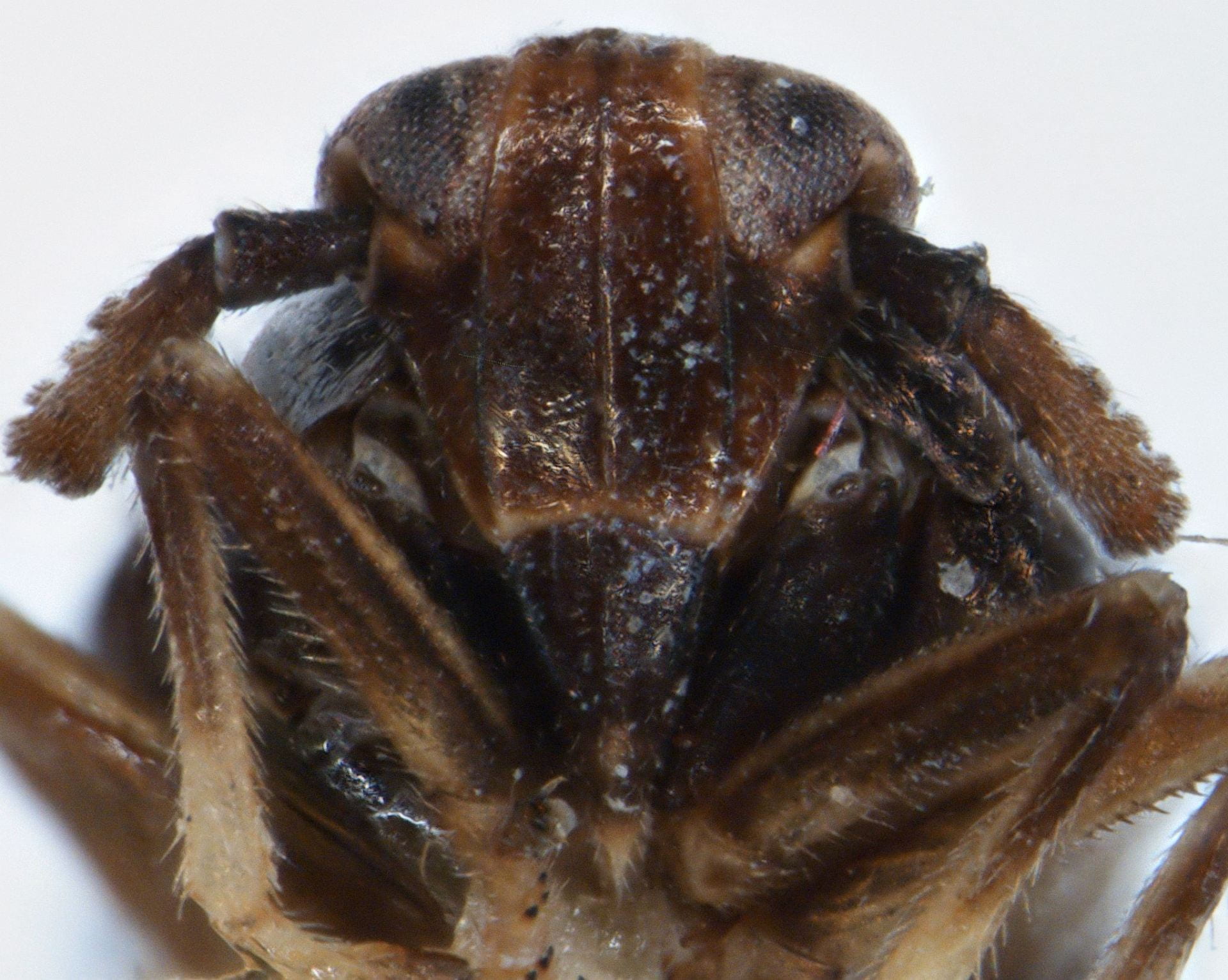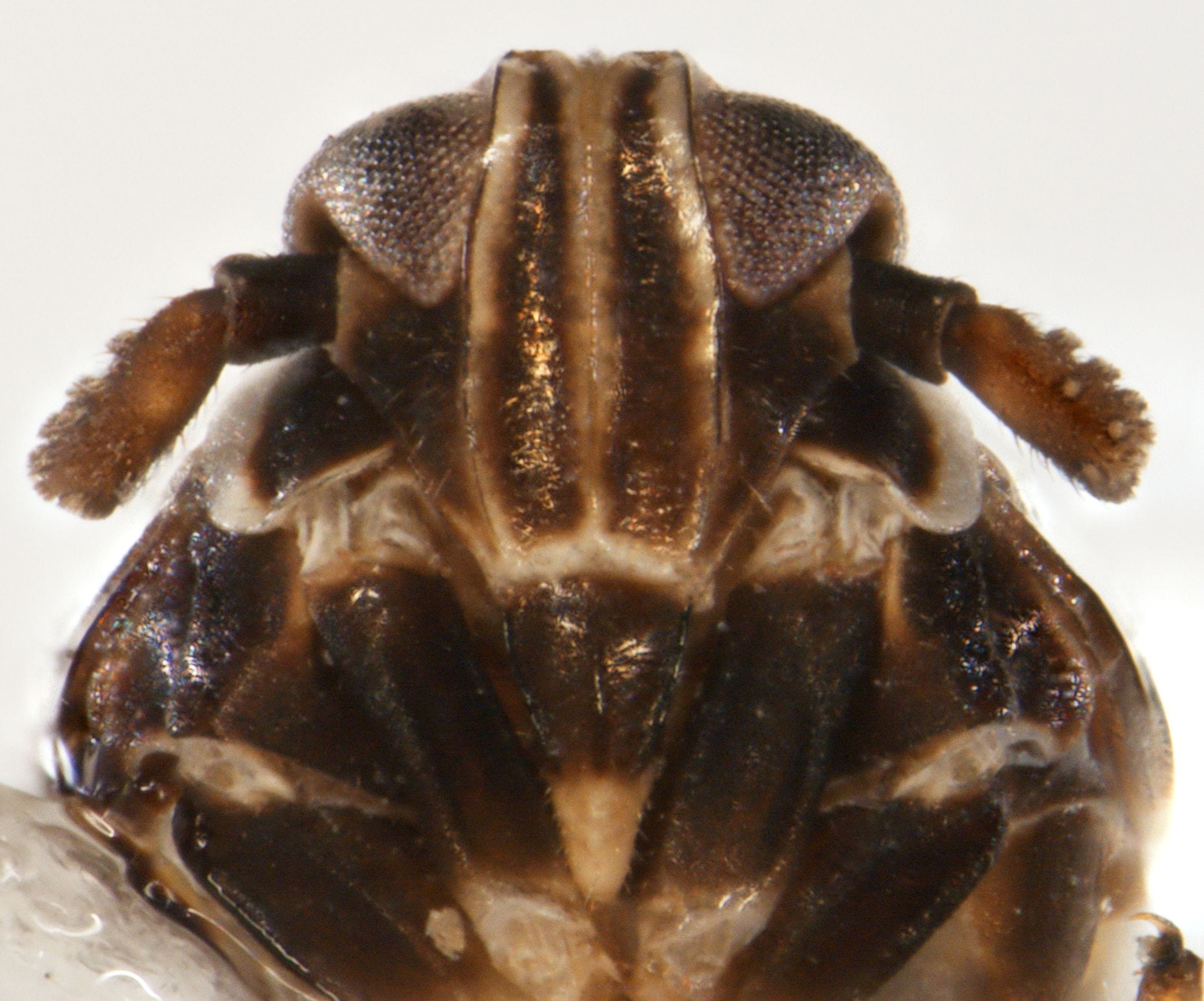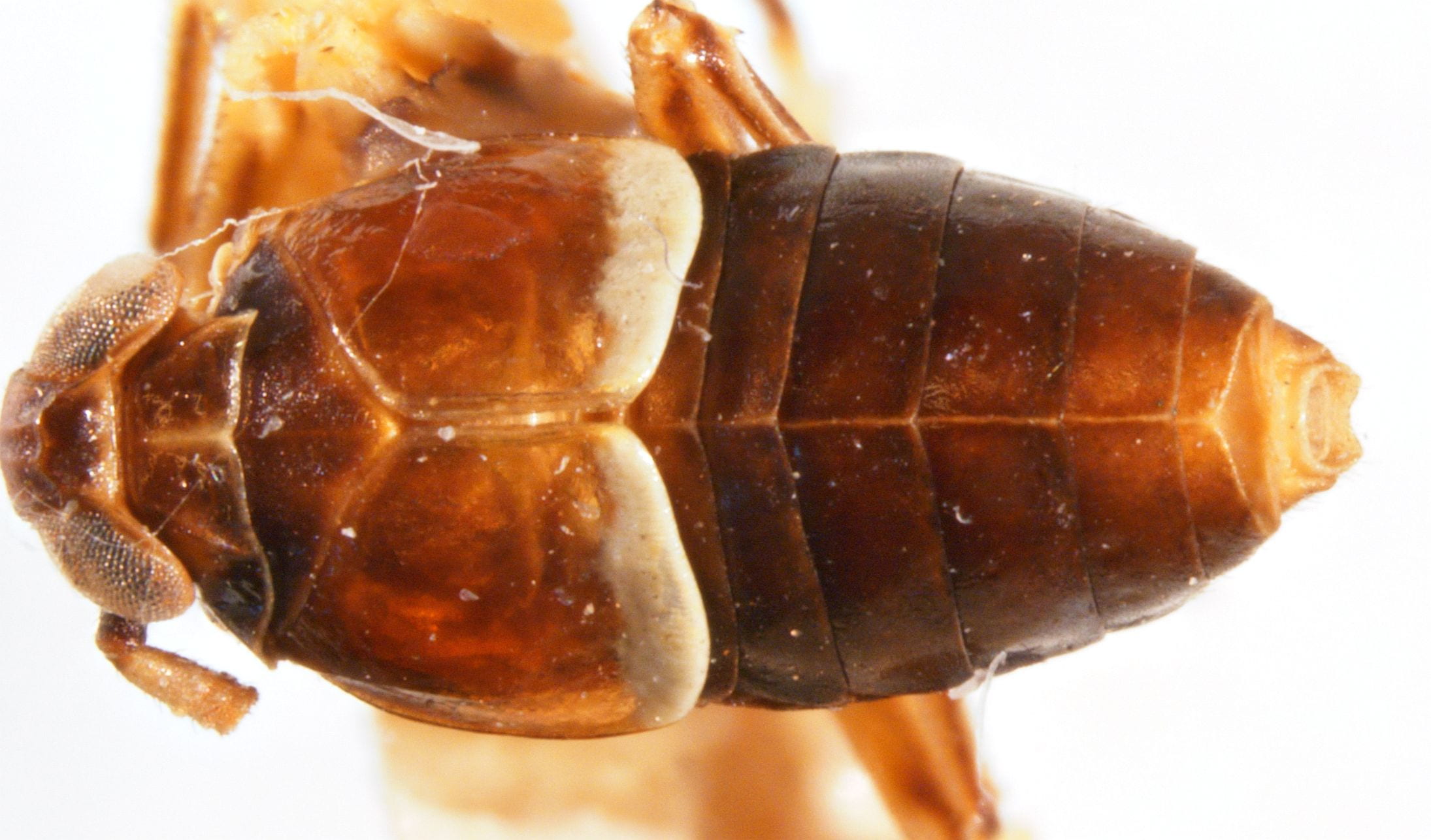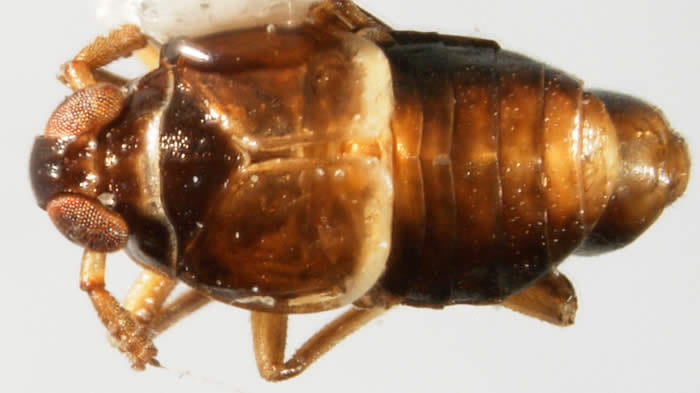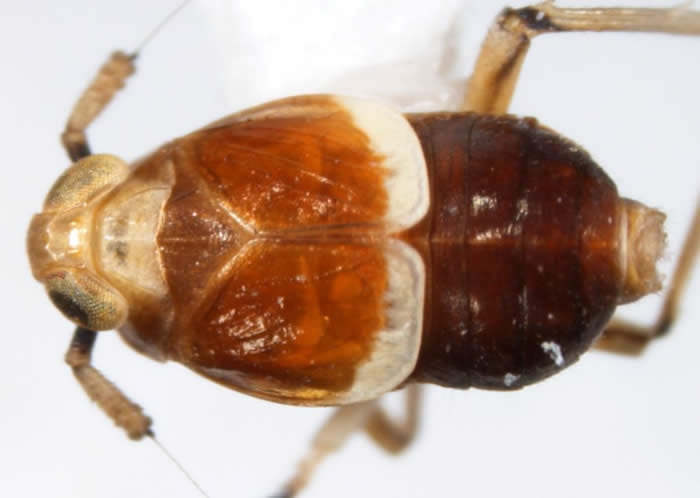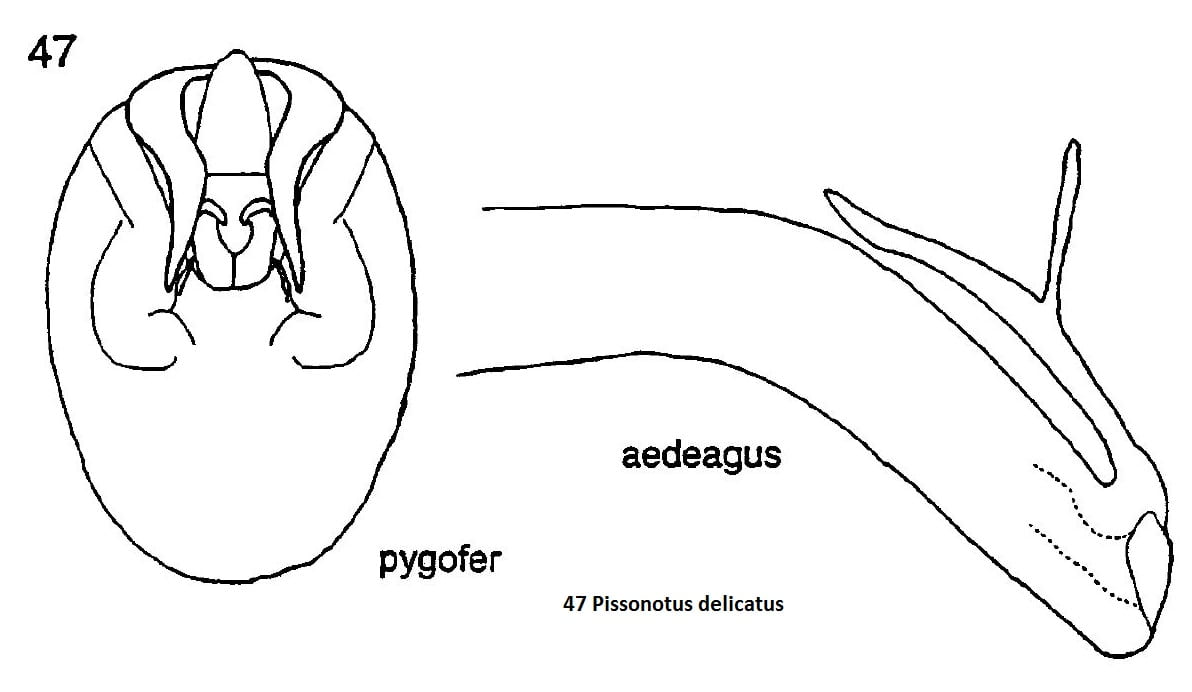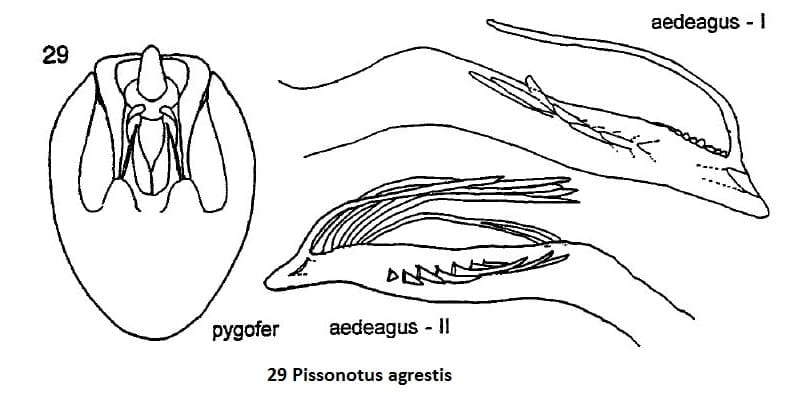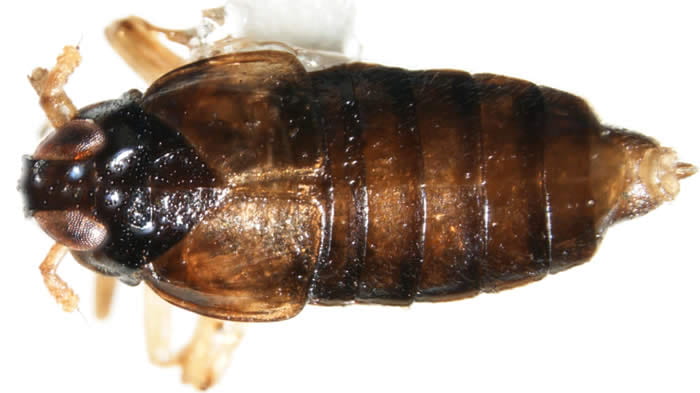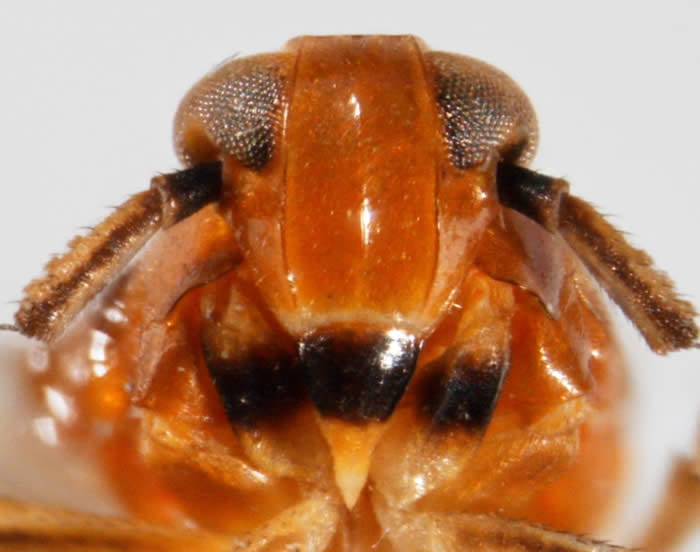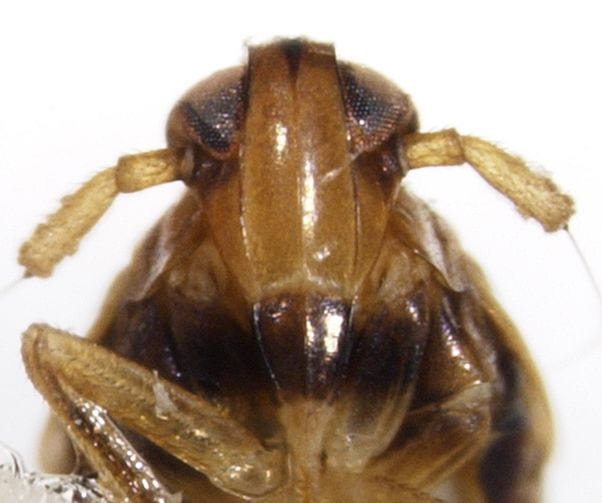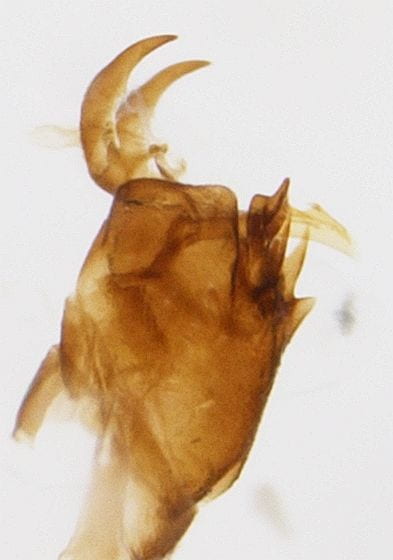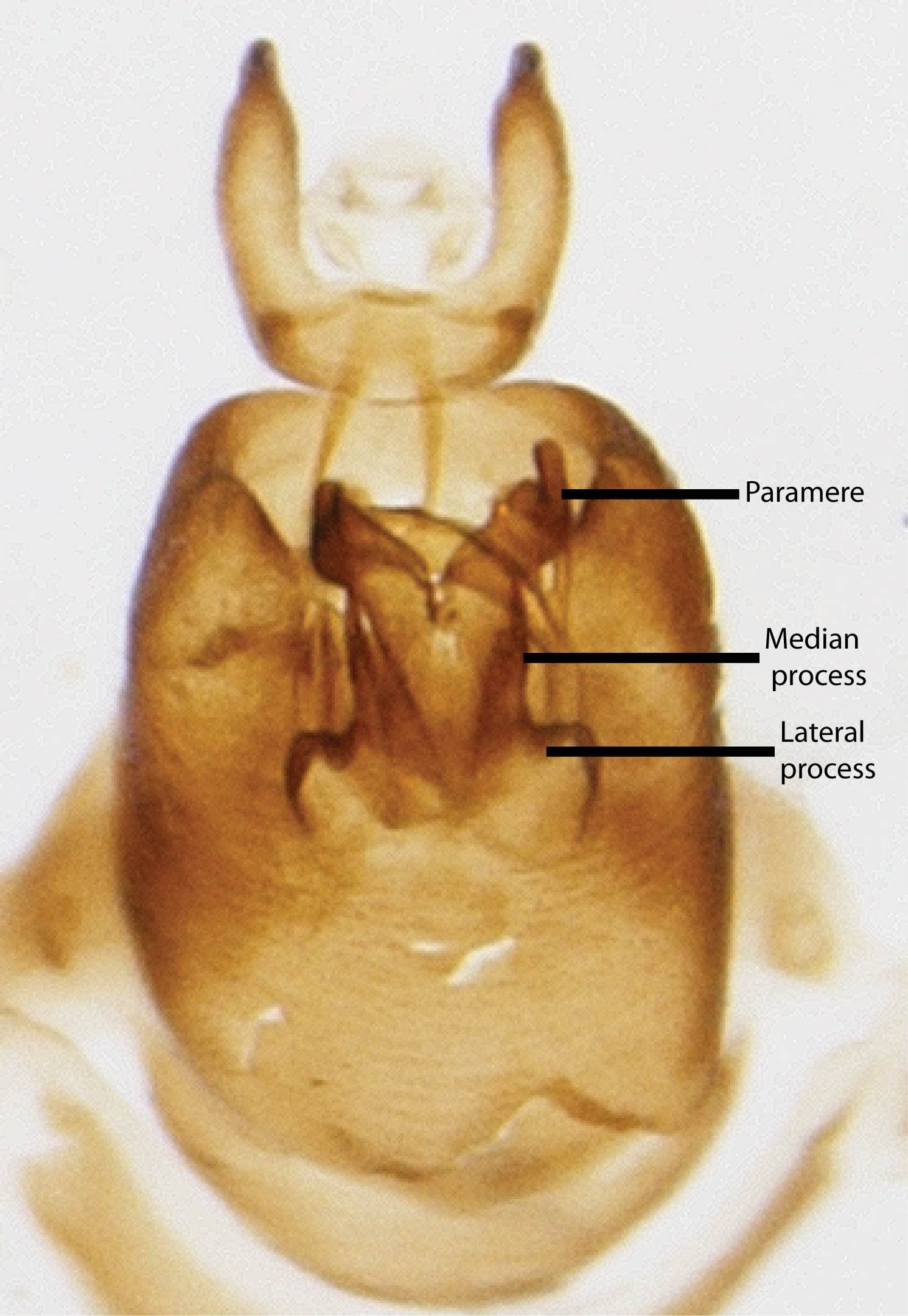This key is modified from Bartlett & Deitz 2000 (it is too long to include on the Pissonotus page). Line art from Bartlett & Deitz (2000), photos University of Delaware. I intend to post a key to western US, and maybe tropical Americas at a later time.
Pissonotus page (Planthoppers of North America)
Key to Pissonotus Species of Eastern and Central United States and Canada
(brachypterous males, modified from Bartlett & Deitz 2000)
1. Front tibiae flattened and laterally (width 0.12-0.33 mm; Figs. 4-6) … 2
1′. Front tibiae not expanded (width 0.06-0.10 mm; Fig. 3) … 8

Front legs of Pissonotus: 3. P. albovenous (tibiae not expanded); 4. P. basalis (slightly expanded); 5. P. neotropicus; 6. P. tesselatus (expanded)
2(1). Frons maculated (spotted) … 3
2′. Frons immaculate, with or without white transverse band on epistomal margin … 6

Front habitus of Pissonotus delicatus (not unspoted frons and white band above frontoclypeal suture contrasted with dark clypeus)
3 (2). Tegmina with white transverse band on distal margin; most veins not reaching distal margin. Widespread, eastern & central US … P. flabellatus (Ball)
3′. Tegmina without white transverse band on distal margin; veins reaching distal margin … 4
4(3′). Venation reticulate; body length (brachypterous male) 1.75-2.25 mm; front tibiae 0.15-0.22 mm wide. Small species; Southeastern US, Ohio … P. tessellatus (Ball)
4′. Venation normal; body length (brachypterous male) 2.35-2.90 mm; front tibiae 0.12-0.16 mm wide (similar to Figs. 4, 5). Robust species; Northeastern US, southeastern Canada … 5
 5 (4′). Tegminal veins pale; male pygofer with lateral processes very large, subequal to parameres … P. aphidioides Van Duzee
5 (4′). Tegminal veins pale; male pygofer with lateral processes very large, subequal to parameres … P. aphidioides Van Duzee
5′. Tegminal veins dark; lateral processes less than half length of parameres … P. tumidus Morgan & Beamer
6(2′). Frons with distinct transverse white band on epistomal margin. Northeastern & central US … P. spooneri Morgan & Beamer
6′. Frons unicolorous … 7
7 (6′). Front tibiae greatly expanded, 0.22-0.33 mm wide (similar to spooneri); post-clypeus and frons concolorous; pygofer with median processes angular with dorsally and ventrally directed caudal flange. Southeastern US … P. nitens (Van Duzee)
7′. Front tibiae slightly expanded, 0.12-0.15 mm wide (Fig. 4); postclypeus much darker than frons; median processes broad, flattened with small lateral shelves. Northeastern US & southeastern Canada … P. basalis (Van Duzee)
8(1′). Frons maculated (spotted); tegminal veins pale, without distal white transverse band … 9
8′. Frons immaculate, epistomal margin may have white transverse band (above frontoclypeal suture); tegmina variable, usually with concolorous venation … 10
9(8). Body stramineus; dorsum of abdominal segment VI with 4 conspicuous, dark colored, transversely arranged tubercles; antennal segment I often flattened. Coastal, southeastern US … P. quadripustulatus (Van Duzee)
9′. Abdomen with pale maculations, without dark tubercles; antennae terete. Widespread … P. albovenosus Osborn
10 (8′). Tegmina without white distal transverse band, veins reaching distal margin; epistomal margin of frons with white transverse band weak or obsolete; body usually very dark brown … 11
10′. Tegmina with white distal transverse band, veins obsolete before reaching distal margin (if band incomplete, go to couplet 15, band may be absent in females); frons and body color variable … 15
11 (10) Tegminal veins pale; male pygofer with small median tooth just ventrad of median processes; aedeagus without retrose processes, with series of paired dorsal teeth. Widespread, eastern US … P. brunneus Van Duzee
11 ‘. Tegminal veins concolorous with membrane (Fig. 59-63); pygofer without small median tooth; aedeagus usually with retrose processes … 12
12(11 ‘). Median processes broad, strongly flattened with lateral shelves and rounded apices (Figs. 17, 18); anal processes very long, exceeding base of median processes; antennal segment I dark brown … 13
12′. Median processes angular, without lateral shelves; apices convergent and sharply acute (Fig. 20), or divergent (Fig. 16); anal processes usually just reaching base of median processes; antennae stramineus … 14
13 (12). Male pygofer bearing very large, ventral flap with 4 rounded lobes. Northeastern & central US, adjacent Canada … P. niger Morgan & Beamer
13′. Male pygofer without ventral flap, but with ventral C-shaped ridge at base of median processes (Fig. 17). Florida, Texas … P. nigriculus Morgan & Beamer
Pissonotus nigriculus
14(12′). Median processes strongly convergent apically (Fig. 20) … P. concolor Bartlett (dark form)
14′. Median processes divergent apically (Fig. 16) (on Artemisia) … P. divergens Bartlett
15 (10′). Body brownish orange, strongly contrasting with nearly black head (and usually pronotum); median processes convergent (Fig. 28); aedeagus with 2-3 short, simple retrose processes. Central & eastern US … P. guttatus Spooner
15′. Head and body not strongly contrasting as above; other features variable … 16
16(15′). Frons and vertex brown with very conspicuous pale carinae; median processes widely separated basally, strongly convergent to nearly meet apically (Fig. 45); paramere apices hooked, directed ventrally; antennal segment I dark brown. Southeastern US … P. albivultus Morgan & Beamer
16′. Frons and vertex with carinae inconspicuous, concolorous at least in part; median processes and parameres not as above; antennal color variable … 17
17(16′). Median processes strongly convergent apically (Figs. 20, 21, 23, 24); most species (except P. radiolus) with very long anal processes; exceeding base of median processes; antennae stramineus; frons with epistomal margin paler but well-developed white transverse band absent (e.g., Figs. 64, 66, 67) … 18
17′. Median processes parallel or slightly convergent apically (e.g., Figs. 22, 36); anal processes usually shorter (except P. marginatus); antennae and frons coloration variable … 21
18(17). Aedeagus with 1 long retrose process (Figs. 23, 24). Southeastern Canada … 19
18′. Aedeagus with 4-5 retrose processes (Figs. 20, 21) … 20
19(18). Anal processes short, just exceeding apices of parameres (Fig. 23) … P. radiolus Bartlett
19′. Anal processes very long, exceeding base of parameres (Fig. 24) … P. canadensis Bartlett
20(18′). Abdomen with broad middorsal band; aedeagus with distal retrose process fine, second retrose process long and expanded with lateral tooth, abruptly narrowed beyond midpoint (Fig. 21); aedeagus with serrate or crenate dorsal hump proximad of midpoint. Northeastern US, southeastern Canada … P. dorsalis Van Duzee
20′. Abdomen immaculate; aedeagus with 4 simple retrose narrow; aedeagus without dorsal hump near midpoint … P. concolor Bartlett (pale form)
21(17′). Median processes conspicuously flattened with diagonally truncate (Fig. 26) or curled (Fig. 25) apices; very dark brown species with conspicuous white transverse bands distally of tegmina and caudally on pronotum; antennae and legs usually stramineus … 22
21′. Median processes angular; other features variable … 23
22(21). Aedeagus with 2 retrose processes (Fig. 26); apices of median processes diagonally truncate. Southeastern US … P. paludosus Morgan & Beamer
22′. Aedeagus with 2 long and 2 short retrose processes (Fig. 25); apices of parameres curled. Wisconsin … P. aquilonius Morgan & Beamer
23(21′). Median processes 1/3 height of parameres or less (Fig. 47); aedeagus with distal retrose process bifid; antennae usually with I dark brown; II stramineus with brown anterior longitudinal highlight; body color usually brownish orange. Common and widespread, especially western North America (uncommon, and sometimes misreported in east; mostly on Grindelia) … P. delicatus Van Duzee
23 ‘. Median processes at least 1/2 height of parameres (e.g., Figs. 36, 46); aedeagus with distal retrose process never bifid; simple or with lateral tooth; other features variable, color usually dark brown … 24
Front habitus of Pissonotus delicatus
24(23′). Pronotum caudally and tegmina distally with conspicuous white transverse bands; antennal segment I usually dark brown; body color always very dark brown … 25
24′. Pronotum without white caudal transverse band; tegmina with white distal transverse band variable; antennal segment I often stramineus; body color variable … 26
25 (24). Epistomal margin of frons with white transverse band conspicuous; aedeagus with lateral flange of 6-10 closely set processes (Figs. 29) and 5-10 closely set retrose processes (but proximal retrose processes may be reduced to teeth). Florida, Georgia, Connecticut … P. agrestis Morgan & Beamer
25′. Epistomal margin of frons with white transverse band nearly obsolete; aedeagus without lateral flange of processes; with 3 retrose processes (Fig. 27) … P. merides Morgan & Beamer
26(24′). Anal processes very long, arcuate, much exceeding bases of median processes (Fig. 22); pygofer with large caudally directed lobes on lateral margin of opening; aedeagus with 1 retrose process; female without white apical transverse bands on tegmina. Eastern US, southeastern Canada … P. marginatus Van Duzee
26′. Anal processes reaching or just exceeding base of median processes (Figs. 36, 35, 36); pygofer without caudally directed lateral lobes; aedeagus with 4-5 retrose processes; body coloration highly variable … 27
27(26′). Antennal segment I dark brown, II usually paler with brown anterior longitudinal highlight; aedeagus with 4-5 simple retrose processes (Fig. 46); median processes with apices directed medially, acute or rounded … P. binotatus Spooner
27′. Antennae stramineus; aedeagus with 4 retrose processes, most distal with lateral tooth (Figs. 35, 36); median processes with apices blunt and directed dorsally … 28
28(27′). Aedeagus with 2-3 small, paired lateral teeth in row near apex (Fig. 35); frons rounded in front of eyes, vertex little or not produced in front of eyes; body length (brachypterous male) 1.85-2.25 mm; calcar teeth 10-13; color characteristically brownish orange. Mostly Florida; also North Carolina, Illinois … P. dentatus Morgan & Beamer
28′. Aedeagus without lateral teeth near apex (Fig. 26); vertex produced in front of eyes; body length (brachypterous male) 2.20-2.35 mm; calcar teeth 13-18; color usually dark brown but highly variable. Eastern & central US, Montana … P. piceus (Van Duzee)

